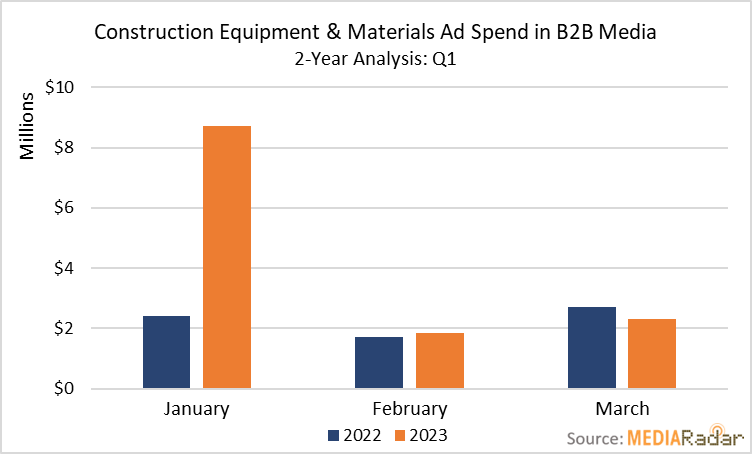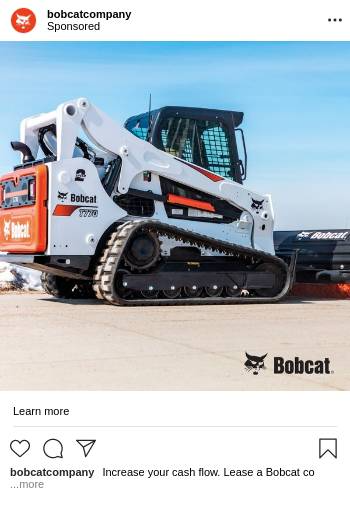It wasn’t long ago that the cost of plywood increased from $400 to $1,500 per thousand square feet or that 68% of contractors said they’d seen a project canceled because of the pandemic.
During the pandemic, the construction industry was turned on its head and taken for another spin as the shaky economy put fear into consumers and businesses.
Unsurprisingly, that impacted how construction advertisers invested their ad dollars, including B2B media. But as the world starts to rebound, advertisers are coming back.
According to MediaRadar’s data sample of nearly 1.9k B2B media publications, construction equipment and materials advertisers from more than 430 companies invested over $12.8mm in B2B media in Q1 2023, representing an 89% YoY increase.
Here’s what you need to know.

January Served As a Launchpad for Construction Equipment & Materials Advertisers
Rumblings of a recession picked up throughout much of 2022. In September 2022, Steve Hanke, a professor of applied economics at Johns Hopkins University, pegged the chance of a recession in 2023 at 80%.
While the chance of a recession in 2023 remains—and even seems inevitable—the economy’s strong finish in 2022 gave advertisers for construction equipment and materials confidence that commercial and residential projects would pick up in the new year.
In January, these advertisers’ spending on B2B media spiked by more than 260% YoY. For example, advertisers from Applied Machinery Sales (AMS), Caterpillar, and Godbersen-Smith Construction Co., increased spending by 180% YoY.

Spending at events like the World of Concrete in Las Vegas was also popular. In fact, over 1.1k brand names spent $26mm+ to exhibit their products, with nearly a third ($8mm) coming from advertisers promoting construction equipment and products, concrete machinery, power tools, industrial concrete, and construction equipment retailers.

For example, nearly 50 construction equipment and product advertisers spent over $3.3mm at the event, including Caterpillar, Fascan International, and Somero Enterprises. At the same time, almost 25 concrete machinery companies—think Alliance Concrete Pumps Inc., New Grind Inc., and Sany Heavy Industry Co.—dished out more than $1.5mm.
Finally, over 30 industrial concrete companies, including Cemen Tech, Quikrete, and Schwing America, spent nearly $1.2mm to tout their products at one of the industry’s marquee events.
Following a modest increase in February by 7% YoY to ~$1.8mm—EXOR increased ad spend for its Case Construction equipment lines by 287%—spending fell in March by 15% YoY to $430mm.
The decrease could indicate that advertisers have seen the writing on the wall scribed by an unstable banking industry that’s already seen the collapse of Silicon Valley Bank.
According to Mike Riddell, senior fixed-income portfolio manager at Allianz Global, “The bigger, medium-term implication of what’s happened in the last month is that global growth will be far weaker in six months than we thought even just a few weeks ago.”
That somewhat gloomy outlook will impact how construction equipment and material advertisers spend on B2B media for the remainder of the year.
The Demand for Concrete (and Ads) Rises
The bulk of B2B media spending from these advertisers comes from those in three categories—two of which involve concrete.

In Q1, advertisers for concrete machinery, industrial concrete, and construction equipment spent more than $8.5mm or 66% of the segment’s investment in B2B media.
For these advertisers, spending comes amid industry growth. According to a market research study, the demand for global high-strength concrete is expected to grow at a compound annual growth rate (CAGR) of 5% between 2023 and 2030, when it’ll reach nearly $508b.
The market for rapid-strength concrete is expected to grow at a similar rate, which could put companies like Aggregate Industries (Holcim Group), Boral Limited, Bostik (Arkema S.A.), and Tarmac (CRH plc) in a position to increase spending on B2B media.
Despite the demand, their situation is no different than their contemporaries elsewhere in the construction equipment and materials industry. The uncertain economy is even impacting the projects of some of the world’s richest companies.
For example, Meta, the parent company of Facebook, Instagram and WhatsApp, announced a construction pause for its new $800mm data center. Google also paused the construction of a data center.
That said, some industry experts expect the demand for these structures to remain strong, which could keep the wallets of these advertisers open.
Danny Horton, senior project manager of the data center division at PCL Construction, said, “While the layoffs have hit the industry hard, new opportunities [for data centers] continue to arise, and we’ll keep seeing momentum and growth for years.”
What’s Next for Construction Equipment and Materials Advertisers?
The strategies for construction equipment and materials advertisers are up in the air. Some experts, like Danny Horton, are bullish on the industry’s outlook, while others fear stagnation.
Advertisers across the industry will respond accordingly and give B2B media some love. That said, advertisers will look to diversify their media mixes by investing in other channels, including online video and paid social.
In Q1, construction equipment and product advertisers increased their investment in digital ads by more than 50% YoY to $6.5mm. Over $2.1mm of that investment in the first quarter went to Facebook and Instagram, including this ad from Bobcat.

At the same time, EXOR (Case Construction), Manitou, and others tapped into outlets like Accuweather, Investing.com, and the New York Post. YouTube even received some love, with advertisers increasing their investment in the platform by 47% YoY to roughly $290k.
For more insights, sign up for MediaRadar’s blog here.



